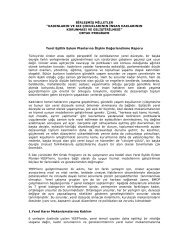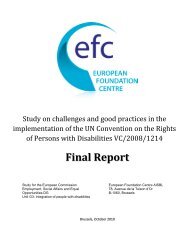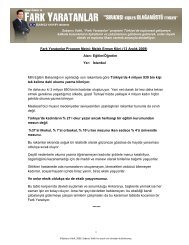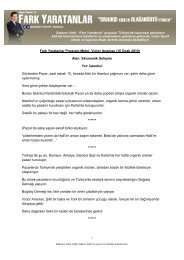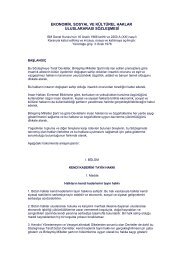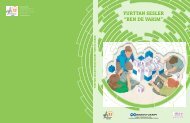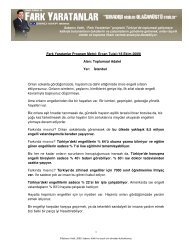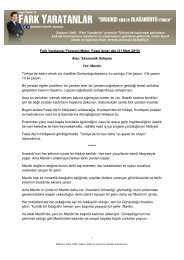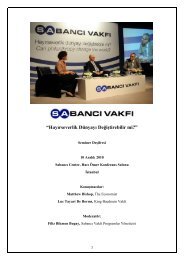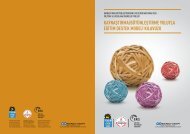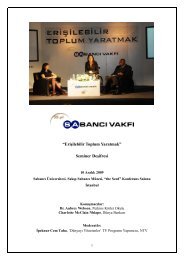UNFPA at Work: Six Human Rights Case Studies
UNFPA at Work: Six Human Rights Case Studies
UNFPA at Work: Six Human Rights Case Studies
- No tags were found...
You also want an ePaper? Increase the reach of your titles
YUMPU automatically turns print PDFs into web optimized ePapers that Google loves.
health-rel<strong>at</strong>ed requests and decisions in accordance withtheir rights. For example, they will be more likely to ask theirhealth-care providers to give them medical inform<strong>at</strong>ioninstead of merely an examin<strong>at</strong>ion and tre<strong>at</strong>ment.The Choose a Future programme aimed to fulfil the right tohealth in other ways as well. The young participants learnedto recognize themselves as members of society, and tothink about making positive changes in their own lives andin society. The training sessions also helped the girls torealize the power of being united. They learned th<strong>at</strong> even asadolescents, they could work together to develop rel<strong>at</strong>ivelysophistic<strong>at</strong>ed responses to social problems th<strong>at</strong> thre<strong>at</strong>enedtheir well-being. (See the ‘Results’ section for examples ofthe girls’ initi<strong>at</strong>ives.)Facilit<strong>at</strong>ors helped girls to develop action plans, andencouraged them to form their own reproductive healthawareness groups <strong>at</strong> the completion of the course. Theseactivities have the potential to prepare girls to becomeempowered rights-holders as well as active participants ina vibrant civil society.Although the training sessions did not focus specifically onintern<strong>at</strong>ional human rights instruments, they encompassedinform<strong>at</strong>ion about the right to educ<strong>at</strong>ion and reproductiverights. They also led participants to considerrights-rel<strong>at</strong>ed objections to early marriage, caste discrimin<strong>at</strong>ionand chaupadi. 8The course facilit<strong>at</strong>ors sought to form trust-based rel<strong>at</strong>ionshipswith the participants, which led the young people toshare some of their personal difficulties. This helped thedistrict-level staff of the Department of Women’sDevelopment to learn more about their needs, providinginform<strong>at</strong>ion th<strong>at</strong> some district offices used to developanother phase of the Choose a Future programme. Forexample, the Department’s office in Khanchanpur Districtestablished scholarships to provide free educ<strong>at</strong>ion to programmeparticipants who had left school because theycould not pay the fees.RESULTSTraining and follow-up activities by women’s feder<strong>at</strong>ionsplayed a critical role in encouraging women and adolescentgirls to get to know who they are as members of societyand increased their courage, self-confidence and selfawareness.Girls raised their voices against the day-to-daydiscrimin<strong>at</strong>ion they faced in their families and communities.They became more likely to demand th<strong>at</strong> their parents sendthem and their sisters to school.The training also encouraged women and adolescent girlsto take advantage of other programmes and services. Thegirls expressed an interest in skill-building activities andscholarship programmes. In one district, Choose a Futureparticipants established an Adolescent Club for Girls.There was also increased leadership, activism and particip<strong>at</strong>ion<strong>at</strong> the community level. The training programmesdeveloped the leadership, advocacy and networking skills ofthe women and girls who particip<strong>at</strong>ed. The Choose a Futureprogramme encouraged girls to assertively contest traditional<strong>at</strong>titudes and to collectively challenge disempoweringpractices. They learned the power of negoti<strong>at</strong>ing, organizingand taking action to change traditional practicesharmful to women and girls.Following the Choose a Future training sessions, girls spokeout against early marriage on a number of occasions. Inseveral cases, they were actually able to persuade parentsto stop early marriages. Another accomplishment of somegirls was putting an end locally to the practice of chaupadi.Girls also organized collective programmes to encourageparents to send their daughters to school and to promptolder women to access health-care services. One group ofgirls helped to ensure th<strong>at</strong> a friend’s house was built by collectingfunds and volunteering their labour.The inform<strong>at</strong>ion th<strong>at</strong> women acquired through reproductivehealth training helped them make major changes intheir lives. Women in one district reported th<strong>at</strong> learningthe scientific facts about reproduction led them to stopblaming themselves for not giving birth to male children.Some women even educ<strong>at</strong>ed their husbands and otherrel<strong>at</strong>ives about the biology of reproduction so they wouldbetter understand how the sex of a baby is actuallydetermined. Similarly, the Choose a Future training sessionsempowered adolescent girls to change their reproductivehealth-rel<strong>at</strong>ed behaviours and to seek healthservices. The positive outcomes of the Choose a Futureprogramme also led a group of boys to ask the girls toinclude them in their club, after the boys saw how8 Chaupadi is the practice of segreg<strong>at</strong>ing women while they are menstru<strong>at</strong>ing because of traditional beliefs associ<strong>at</strong>ing menstru<strong>at</strong>ion with impurity. Besides being anaffront to women’s dignity, chaupadi often has neg<strong>at</strong>ive health consequences because of the poor condition of the facilities (often barren outbuildings) in which manywomen are confined.NEPAL31



